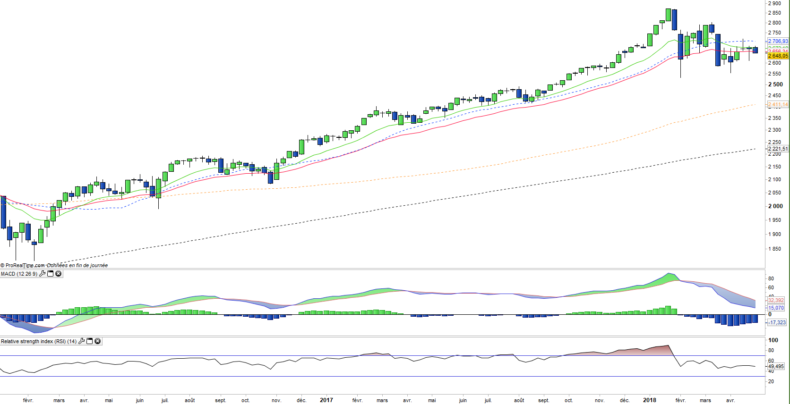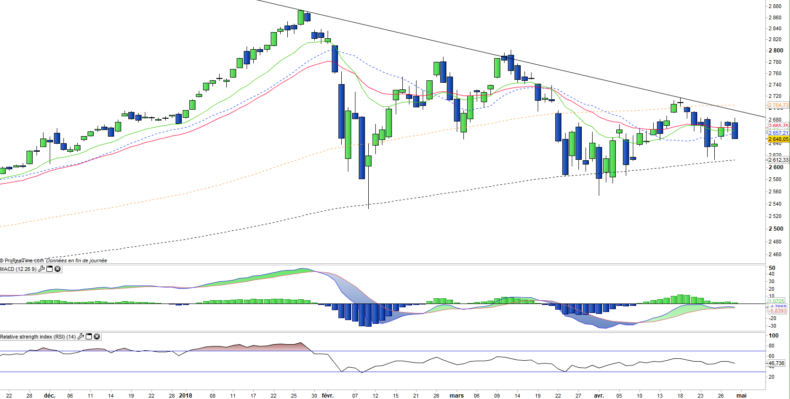SPDR S&P 500 (SPY) - 01/05/2018
Short Term strategy: Negative (30%) / Trend =
Long Term strategy: Positive (90%) / Trend -
Characteristics of the ETF
The SPY ETF (SPDR) created in 01/1993 replicates the S&P500 index, which is composed of the 500 main US stocks representative of the main sectors, while the stocks are selected according to the size of their market capitalization.
The ETF fees are quite low at 0.0945% and the AUM is $256bn. Replication is direct (physical) and there is a dividend distribution policy on a quarterly basis.
Alternative ETFs: AUM5 (Amundi in Euro), SP5 (Lyxor in Euro), IVV (iShares, in USD)
Latest developments
After a 19.4% increase in 2017, and a sharp rise in January (+ 5.6%), the S&P500 suffered a correction in February and March but recovered in April thanks to satisfactory corporate results, as well as a lower rhetoric between D.Trump and China at the level of trade.
The index has lost about 0.7% since the beginning of the year and remains constrained by a certain number of themes, such as the rise in long-term rates that cross the 3% level, the high valuation of the indices while the growth cycle seems mature, the risk of trade war with China and Europe, and the problems in the Middle East with Iran in particular. On the other hand the massive tax cuts decided by the Trump administration are expected to strongly impact corporate profits in 2018, and the resumption of oil prices is currently good news for the US industry.
The index seems so for the moment capped both upward and downward, in the absence of major slippage.
Index & components
The top 10 stocks of the S & P500 include five major technology stocks (Apple, Amazon, Microsoft, Alphabet and Facebook), but also larger, more classic and iconic American companies such as JP Morgan or Exxon Mobil.
The main advantage of this index is its depth, which allows it to be a good proxy for the US economy, with a sector weighting that favors the growth sectors a little more, just like the technology stocks that represent about 25% of the weighting. Financials account for just under 15% of the index, and energy values of 6% are well balanced by defensive sectors such as health (about 14%) and consumer discretionary (13%).
The index has benefited from a strong momentum since the election of D. Trump, more than a year ago, while alongside the technology that remains the engine of the US market, new sectors have joined the trend, however a correction is now underway on the index because of fears of a return of inflation following the program of lower taxes for US businesses and households that should have a positive impact on growth, while announced deregulation on shale oil and banks could also benefit these sectors.
However the multiples of the S&P500 are currently quite high, even after the ongoing correction at around 19x the results at 12 months, which is at the top of range (historically between 15 and 20x) even if US economy growth is estimated at around 3% in 2018. The whole question is now about the duration of the US cycle in a context of rising rates which is still progressive for the moment while the level of margins companies is at its highest level and seems to have lost much upside potential, even though the consensus is again on double-digit earnings growth in 2018 driven by the energy / oil sector, banks and technological stocks.
Weekly data
The weekly chart shows a recovery above the EMA26, after a new bearish start that failed to sustainably accelerate the decline. The candlestick of the previous week has a long tail which marks the sellers failure. A new confirmation is now needed to confirm the recovery above the main moving averages and the recovery of the bullish trend.
Daily data
On the daily chart, one can see the third consecutive rebound that occurred in April on the EMA200 days. This contact once again allowed the index to rebound while forming a bullish gap at 2645 pts. This gap is now under pressure but if it is not filled over the next few days, it would be a sign of strength for the index. This rebound will have to cross the 2700 pts level to be confirmed.
ETF Objective
SPY is an ETF listed in $, which seeks to replicate the S&P500 index (505 US companies)
Characteristics
| Inception date | 22/01/1993 |
| Expense ratio | 0.09% |
| Benchmark | S&P 500 |
| Issuer | SPDR |
| Ticker | SPY |
| ISIN | US78462F1030 |
| Currency | $ |
| Exchange | NYSE Arca |
| UCITS | No |
| Assets Under Management | 255 857 M$ |
| Replication method | Direct (Physical) |
| Dividend | Distribution |
| Currency Risk | No |
| Number of Holdings | 505 |
| Risk | 3/5 |
Country Breakdown
| USA | 100% |
Sector Breakdown
| Information Technology | 25% |
| Financials | 15% |
| Health Care | 14% |
| Consumer discretionary | 13% |
| Industrials | 10% |
| Consumer Staples | 7% |
| Energy | 6% |
| Others | 10% |
Top Ten Holdings
| Apple | 4% |
| Microsoft Corp | 3% |
| Alphabet | 3% |
| Amazon | 3% |
| 2% | |
| JPMorgan Chase | 2% |
| Berkshire Hathaway | 2% |
| Johnson & Johnson | 2% |
| Exxon Mobil | 1% |


